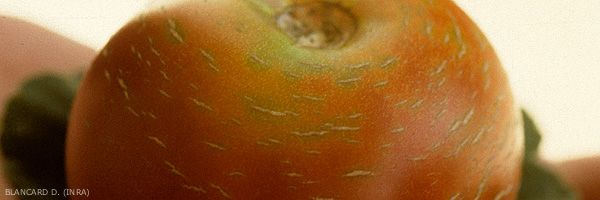
Fruit microcracks linked to stress (phytotoxicity or climatic accident) ( russeting)
Symptoms on fruits
The epidermis more or less superficially suberized, greyish in color, also revealing a multitude of concentric slits several millimeters long (figure 1). The areas of the fruit particularly exposed to the treatments are the most affected.
Lesions can appear in the open as well as under cover.
Origin of damage
Non-parasitic disease
Superficial burns of the epidermis (and therefore loss of its elasticity) following the application of one or a mixture of inappropriate pesticides or those applied under bad conditions.
How to cure it
Unfortunately, the damage observed is irreversible, "the damage is done". Particular care should be taken during the next phytosanitary treatments.
The chemical injury can cause other symptoms on fruit.
It should be noted that in the literature, several other non-parasitic conditions are reported to be responsible for microcracks in the stalk zone of green tomato fruits.
Among them, let us quote the fruit russeting , also called “ shoulder checking ” or “ weather checking ”. This disease is thought to be due to the presence of water (following irrigation, rain, dew) on the surface of the fruits for too long a period, this at a time of the year during which the mornings remain cold.
A fairly comparable condition is described under the name " rain check ", characterized by the development of tiny concentric bursts, in the stalk region of the fruits, sometimes united to form larger bursts. These micro-bursts locally give the surface of the fruits a harsh touch and modify the development of their color: they remain green when ripe or progressively blacken in the area concerned (figures 2 and 3). The cause or causes of this disease are not yet known. As with the russeting fruit, the most exposed green fruits are the most affected. In addition, the phenomenon also manifests itself following rains occurring after a period of drought. Note that varietal differences are noted. Cultivars with extensive vegetation covering the fruit well appear to be less susceptible. In addition to using tolerant varieties, all agro-cultural measures to maintain the plant cover in place or protect it from pests will be wise to control this phenomenon.
Finally, another affection, with the undetermined cause, the cause black shoulder , would spots, grayish streaks in the peduncular zone of the green fruits. These lesions would spread more or less later and would take on a dark gray to black tint. The microcracks present on the fruits would facilitate contamination by Alternaria alternata , which would settle in the tissues and locally cause them to rot. The appearance of this condition would seem to be associated with the same conditions as those influencing the development of the rain check . Varietal differences would exist.





